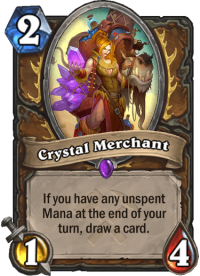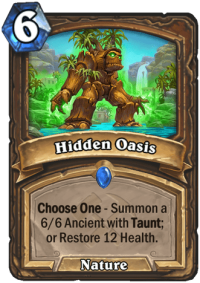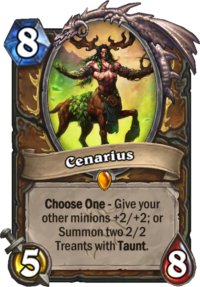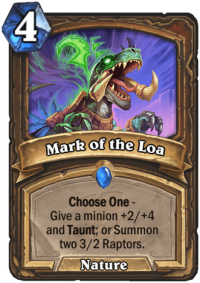Our Quest Druid deck list guide for the Saviors of Uldum expansion features one of the top lists for this archetype. This Druid guide includes Mulligan Strategy, Gameplay Tips, Card Substitutions, and Combos/Synergies!
Introduction
Quest Druid is a brand new archetype spawned by Saviors of Uldum, one which revolves around holding back in the first few turns of the game and then leveraging the quest’s ultra-powerful reward to make a comeback on the board and overwhelm your opponent. While its gameplan is fairly linear, there are many edge cases to pay attention to that can make you find or drop a few percentage points in your winrate, especially when you make your mulligan decisions.
- 0Quest Druid Deck List Guide – Saviors of Uldum – August 20191
- 0Quest Druid Deck List Guide – Saviors of Uldum – August 20191
- 0Quest Druid Deck List Guide – Saviors of Uldum – August 20192
- 0Quest Druid Deck List Guide – Saviors of Uldum – August 20192
- 0Quest Druid Deck List Guide – Saviors of Uldum – August 20192
- 0Quest Druid Deck List Guide – Saviors of Uldum – August 20192
- 1Untapped Potential1

- 1Worthy Expedition2

- 2Crystal Merchant2

- 3BEEEES!!!1

- 3Ferocious Howl2

- 3Wardruid Loti1

- 4Flobbidinous Floop1

- 5Anubisath Defender2

- 5Oasis Surger2

- 5Starfall2

- 6Hidden Oasis2

Mulligan Guide and Strategy

Higher Priority (Keep every time)
- Untapped Potential – Unlike with some other Quests in the past, there’s no scenario under which you’d like to have a different card. Your whole gameplan revolves around completing this ASAP.
- Questing Explorer and Crystal Merchant – These are your primary draw tools in the early game, and since you’ll have to wait until Nourish
- Oasis Surger – This is your primary payoff immediately after the quest is completed. Two 5/5 minions with Rush are usually good enough to get you back on the board even if you miss out on most of your other tools during the preparation phase – and crucially, unlike Starfall, they leave bodies behind.
- Worthy Expedition – An excellent way to tailor your gameplan around the board state while utilizing some of your mana in the early turns.
Lower Priority (Keep only if certain conditions are met)
- Starfall – This is your best option for a full clear immediately after your quest is completed, and it should always be kept against aggressive opposition.
- BEEEES!!! and Wrath – Uncharacteristically, you’d prefer having these cards in the early game as removal tools instead of the otherwise ubiquitous Swipe: since you’d either risk having to delay your quest completion by one turn by casting it on curve or severely reducing its impact (especially considering how the card has no synergy with Ossirian Tear).
- Hidden Oasis – When played with both effects active at once, this is a brutally strong one-card stabilization tool against aggro – however, it’s not quite good enough on its own if you didn’t otherwise have an impact on your opponent’s board over the course of the first five turns, therefore it should only be kept if the rest of your hand lines up well against early aggression.
General Playstyle and Strategy
Vs Aggro

Since you have inevitability against every aggressive deck in the game by pushing them off the board and healing back up with Hidden Oasis, your goal is to leverage your spendable mana every turn as well as possible so that you can clear up the mess on the board in one fell swoop once your quest is complete. (Yes, having the Coin speeds up that process by a whole turn as casting it on turn one makes that turn count towards it as well.)
Questing Explorer and Crystal Merchant are your MVPs here, doubling as card draw and damage reduction tools. In certain edge cases, it could be worth delaying your quest by one turn if a Swipe or a Moonfire fully clears the opponent’s board, but only if you have a proper follow-up that makes the time investment worth it.
Once you’ve received your reward, it’s time to clean house. Play exclusively for board control – with so many buff tools in your deck, you will rarely have to direct minion damage towards your opponent’s face to be able set up lethal the following turn. Since you’ve spent the first few turns taking a beating, you need to make sure you take little to no damage from your opponent’s minions from this point on. Eventually, Hidden Oasis will checkmate them. Note that it’s sometimes a good idea to hold back on Druid of the Scythe just so you can play it as a healthy 4/4 taunt: since almost every minion in this deck has Rush, you can be much more liberal with your spell-based removal than you’d normally be when you’re playing defense.
Vs Control

Quest Druid’s playstyle is actually quite analogous with Token Druid’s against slow decks, though the early turns play out very differently. Your goal there is to put up as much minion pressure as possible without risking your early quest completion, so that you can hit the ground running with minion buffs as soon as possible.
Keep in mind that the deck only has Swipe available as reach once the quest is complete (you can’t even ping face with your original hero power in the late game), therefore staying on the board is of paramount importance. However, unlike a Token Druid deck, so many of your minions have Rush that you can actually claw your way back even if you get pushed off at one point during the game. Eventually, Power of the Wild, Tending Tauren and Cenarius will combine one way or another for a quasi-Savage Roar effect to finish off the game.
The real challenge in these matchups is to pace out your threats, always presenting enough to make your opponent commit to removal without overextending yourself. Nourish is an MVP in these matchups, though it’s still too slow to keep in your opening hand as you can’t afford to just pass your way to the quest completion.
Card Replacements

Quest Druid has a surprising number of flex spots: Power of the Wild, Tending Tauren and Cenarius can all be swapped around in some capacity as they fulfill fairly similar roles. If you find that Questing Explorer is too inconsistent, those can be two further slots to swap around.
Depending on how aggressively you want to shore up the Warrior matchup, you can slot in King Phaoris alongside a cheeky The Forest's Aid, and you can also consider Mark of the Loa or Chef Nomi as well – note that these minions synergize extremely well with Flobbidinous Floop as long as you can keep up with the opponent’s resource generation.
On the other end of the spectrum, Ferocious Howl serves as further health gain against aggro, Bloodmage Thalnos as another card draw tool which also increases the consistency of your board clears and Innervate for a more consistent early curve (and faster quest completion).
Leave a Reply
You must be logged in to post a comment.



How does everyone feel about Elise the Enlightened in this deck? I just opened her last night, and this archetype seems like the closest fit I have right now–I’ve seen people include her in non-highlander quest decks either for a burst of late game value (e.g., double Zephyrs/Floop/Nomi/Cenarius) or to setup a big Malygos/Moonfire turn, however both approaches seem wonky and nonviable. Plus of the latter, I only currently own Cenarius and I don’t really want to spend dust on “just a meme”.
i do run elise in my version, but i actually don’t ever get to play her, and i’ve been considering cutting her.
In practice, there’s a lot that goes into playing Elise in this deck.
First, you have to achieve the highlander requirement. Elise is a dead card until that happens.
Second, you have to be mindful of your hand and have cards worth duplicating. In most cases, you won’t have an issue achieving this, but I’ve found that managing my hand size and trying to play Elise to get some value is proving challenging. The best comparison that comes to mind is Barista Lynchen in battlecry Shaman. You wanna get at least 2 half-decent battlecries with Lynchen to get value. In that same light, landing an Oasis Rager or a Starfall against a murloc/board heavy deck can be fantastic. But again, that vlaue only comes into effect when your deck has no duplicates, which is incredibly rng-dependent and might not happen until late into the game when Elise isn’t needed to close the game anymore.
Simply put, there’s a huge criteria that she needs to complete before she can be played, and I haven’t had the chance to play her at all thanks to that.
Zephrys is a completely other issue, his low cost and easier criteria makes him that much more useful as a flex card, while Elise falls into a win-more category, in my mind, since she duplicates cards in your hand at a stage in the game when duplicating usually won’t solve much. In a matchup against a murloc deck, Elise will be playable usually after you 1) used all your Starfalls, and can’t duplicate anymore and 2) exhausted the murloc player’s resources. In other words, it’s an easy win without the need for Elise to close the game.
Sorry, I’ll try concluding again. Her win-more style (requiring you to have decent cards in your hand that you didn’t play because you do’t need them, probably because you’re already winning) and the requirement to transition to Highlander during the game means that Elise’s requirements are just too steep to get any genuine value from her. She’ll probably work better in an experimental Highlander Druid deck, where duplicating your hand supplements the Highlander handicap, theoretically, again. Since if you have a good card in your hand that means you don’t need to use it, so having more copies of a card you don’t need sounds pretty null to me.
You need Elise for the Warrior matchup. I don’t have her and playing quest druid I’m 0-3 vs warriors just today. I’m new to the matchup from the druid side but I played a lot of control warrior last month and found it was almost impossible to lose versus druids cause you have more removal than they have threats.
She’s invaluable in control matchups which this deck encourages. I was able to win through her in matchups like Reborn Paladin, Control Warrior, Quest Shaman, and mirror matchups. So I’ll admit I was wrong about her initially since people seem to hate matching up with quest druid so much they just concede rather than play the long game.
Mark of the Loa can be tricky–if you’ve completed the quest and don’t have any minions on board, the game won’t let you play it for the 2 raptors without also buffing one of your opponent’s minions.
That’s true, but +2/+4 with Taunt and 2x 3/2 for 4 mana is a pretty good card after you’ve finished Quest. And let’s be honest, majority of time you will have something to play first anyway. After playing over 20 games with the deck (with Loa in the main list instead of Questing Explorer) I ran into situation you’re describing only once (and I just played Nourish instead and dropped Mark next turn :p)
What about a replacement for Wardruid Loti? Feel weird to craft her
You have a list of card replacements at the bottom. Mark of the Loa is a solid replacement.